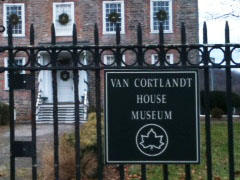I got in touch with a couple of friends, Meghan (who accompanied me to Historic Richmond Town) and Christine, a Roadside Attractions newbie. I told them about my plans to visit the house and experience the “Enchanted Evening” with me. I may have even made a joke or two about a dirty hippie pagan orgy in the woods. Despite my puerility, they agreed to come along for the trek. They deserve credit for being truly sporting young ladies.
I took the 1 train as far north as it would go, getting off at the Van Cortlandt Park – 242nd St. station. The museum was easy enough to get to from there, up a gravel path away from Broadway, past a large swimming pool now closed for the season. I walked around it once, taking a few pictures in the fading evening light. I’d figured I would show up early and investigate the house before the night’s walk, which was set to begin at 5 p.m. This is where things took a turn.
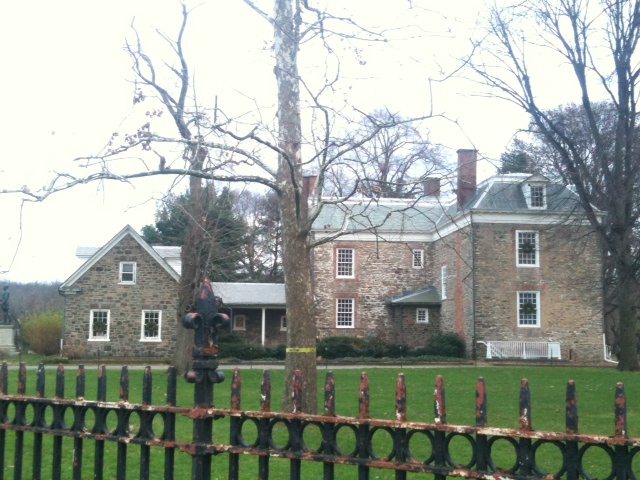
The museum had closed at 4 p.m., and I’d arrived only a few minutes after. I thought to myself, Why would they close the museum if a tour is supposed to leave from here in an hour? Well, I’ve since realized the cause of my confusion. Not being a resident of the Bronx, I didn’t know anything about Van Cortlandt Park before this excursion, and I seem to have assumed that anything going on in this huge park, New York City’s fourth largest, must necessarily have something to do with the famed Van Cortlandt House on its premises. Turns out that, while I did see a lot of events specifically associated with the house on the Parks Dept.’s website, this particular event was in no way affiliated with the house museum. I was able to confirm my error with a museum employee leaving the site shortly after Meghan and Christine arrived. Luckily, the employee was able to tell me where we could go to participate in the solstice walk, and we set off.
The group was supposed to meet at the Van Cortlandt Golf Course, so the three of us had to walk through a bit of woods before arriving. Between the house museum and the golf course we found ourselves walking a boardwalk crossing a marsh labeled as Tibbett’s Brook. Having grown up in Florida, I can vouch for these being what one might properly refer to as wetlands. I later learned that the brook and the area around it was named for George Tippett, an English settler in the region whose descendants were later driven from the area by American revolutionaries because of the family’s Loyalist sympathies. Before that, the Lenape had called the brook “Mosholu,” meaning “smooth or small stones,” of which I saw none. The word “Mosholu” is now commonly used to name Bronx landmarks and roads. Once we’d successfully crossed the brook, the Van Cortlandt Golf Course clubhouse rose into view.
We were a little early, but I expected to see someone with a small semblance of authority nearby. As dusk was darkening the sky, we saw a lone golfer approach the clubhouse and enter. We decided to follow him in, but above the entrance we noticed a sign stating this was the first public golf course in the United States and that it opened in 1895. I read up on it and learned the developers had originally wanted to build a private course, but since the only available land in the area for building a brand-new course was owned by the city, they compromised to make it a public course at the city’s behest.
Once inside, the only soul we could find to explain anything was a young man working the lounge area. He couldn’t explain anything, except to say the solstice walk we were looking for was definitely not sponsored by the golf course, but that several programs met out in front of the clubhouse. Since we still had about 15 minutes to kill, and since it was becoming so chilly out, we decided to wait inside the clubhouse. I ordered a coffee from the lad, but there was no sugar available, much less sweetener. Meghan joked about marrying the clubhouse attendant. While she could do worse, I’m pretty sure she could do a lot better. We watched pro golfers hit balls among palm trees on some southern coastline on a big-screen TV in the corner of the lounge and wished we were somewhere tropical.
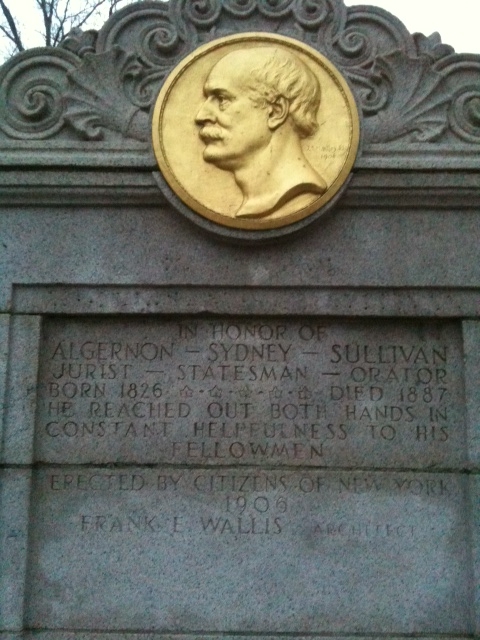
We left at about five minutes till and, to our thankful surprise, found a pair of park rangers just getting out of a Parks Dept. van outside the clubhouse, near a small fountain memorializing Algernon Sydney Sullivan, who was a native of Indiana and a lawyer by trade. He made something of a name for himself as an early advocate of public schools before moving to New York in 1857. There Sullivan caused a scandal by defending the crew of the Confederate schooner Savannah, whom he helped avoid the death penalty. He later co-founded the law firm of Sullivan & Cromwell with William Nelson Cromwell, and became widely regarded as a solid dude for his continued advocacy for charitable and public welfare initiatives. To this day a foundation in his name awards scholarships to those in need, but I was unable to discover any specific reason that a memorial to the man should be built on this particular golf course.
Ranger Mike—a big, strapping, somewhat stereotypical park ranger type—introduced himself and Ranger Katie, a sweet, young, blonde woman who was just adorable. Once out of earshot, Meghan intimated that she now planned to marry Ranger Mike, and I for one think she traded up. By then a couple of families with small children had assembled around us, and Ranger Katie said we’d have to wait a few minutes to make sure stragglers could join us on the walk.
A few minutes of shivering passed (it was around 40 degrees out, maybe less) as several more families with small children parked and joined the group. Meghan and Christine pointed out a childless couple who looked to be in their early twenties, and we breathed a collective sigh of minor relief to know we weren’t the only non-breeders in attendance. Ranger Katie spoke up, breaking to us the unfortunate news that, due to cloud cover, we wouldn’t be able to use the telescopes they’d brought for viewing the astronomically pertinent aspects of the night’s program. It was kind of a bummer, but there really is nothing to be done about the weather. Ranger Katie immediately had a special rapport with most of the children there, and they huddled around her like a flock of ducklings as she led the way from the clubhouse into the dark of Van Cortlandt Park. I feel I should point out that, despite what it said in the advertisement, no candles were distributed.
The first feature we came to was a bit of old bridge and track that Ranger Katie informed us used to serve as part of the Old Putnam Trail, one of the first railroad lines leading out of the city and into Putnam County, hence its name. The line was established in 1869 (though it wouldn’t be completed until years later) by what was originally called the New York & Boston Railroad with the intent of creating an inland route between the two cities. The group crossed over and walked on the side of the trail to avoid muddy depressions in the center.
We came to a clearing down by the Van Cortlandt Lake, which happens to be the largest freshwater lake in the five boroughs. Under the overcast night sky, Ranger Mike gave us some astronomical details relating to the winter solstice, over several interruptions from the know-it-all kids assembled. They must have made their parents so proud, already knowing about the tilt of the Earth’s axis, and why we have seasons, and how Venus is the brightest planet in the night sky. I saw a lot of myself in the little shits. Since we couldn’t see anything for ourselves, Ranger Mike then veered into a short list of websites where the children could learn more about stargazing activities, and then into a curious bit where he seemed to be pitching a sponsored stargazing app for smartphones to the parents. Christine wondered aloud if she would ever not be a member of the small group at the back commenting snarkily at whatever proceedings played out. I assured her it was a perfectly natural response, but that may have been just to assuage myself as well.
Ranger Katie then led us back away from the lake and a little farther up the path, where she drew our attention to a strange, Stonehenge-like row of large blocks of stacked stones. She turned it over to Ranger Mike who explained that, while Grand Central Station was being planned, some of the engineers thought it would be helpful to test the proposed building materials in real weather conditions to rate their hardiness. I mean, this is Grand Central we’re talking about, famous home of the newest Apple Store in the city. Anyway, various kinds of stone and mortar were tested, which all stand to this day in a row of 10 or so columns in the middle of Van Cortlandt Park. As Ranger Mike explained, “in true bureaucratic fashion,” the city ultimately decided to use the stone quarried the closest to Manhattan, which could therefore be acquired for the least expense. There’s your grand experiment, New York.
We followed the rangers up the path to another small bridge in a clearing over the lake. This may have been where Tibbett’s Brook met the lake, but I really have no way of knowing. The rangers said that if we stood quietly for a few minutes, we may see some wildlife across the bridge. I mean, we could hear and barely see, in the reflection of streetlamps across the lake, flocks of geese and ducks floating nearby, but there’s nothing special about that. Species of egret, heron, owls, hawk, muskrat, raccoon, kingfisher, and deer are all known to inhabit the park, but we didn’t see any of them that night. My little snarky group blamed it on the young couple, who audaciously talked through the rangers’ suggested period of silence.
Ranger Mike then spoke up to share some of the cultural and historical traditions associated with the winter solstice. The Romans had their Saturnalia, of course, a festival of lights that was later adapted into our Christmas celebration in the West. The Romans also celebrated a week of misrule at this time, where slaves would become masters and vice versa. The social order was inverted, and the tradition was carried on as the Feast of Fools, mostly in England and France, until no-fun-nik monarchs abolished the practice through the middle ages. The spirit of these celebrations would live on, however, in Carnivale and Mardi Gras, both of which are going strong as ever in some parts of the world.
Ranger Mike gave some other details about the observation of the solstice, which fell on the 22nd this year, which another little smart aleck knew, to which yet another kid interjected something about there being volcanoes at the center of the Earth. This was probably the best interruption all night. Ranger Mike kindly explained why that child wasn’t exactly correct before he told another anecdote about the Sami people of northern Scandinavia, and their belief in a winter goddess-type who arrived around this time of year. Supposedly she rode a reindeer with a taste for dairy, so the people would smear butter on their doorsteps overnight in hopes of attracting her. To have her visit your home was an honor and potentially a mystical safeguard against the harsh winter that was to come.
After wrapping up, Ranger Mike said he’d happily lead a group to the Van Cortlandt House Museum, where Santa Claus was appearing at an event. My little group decided to follow him on the off-chance we could tour the house.
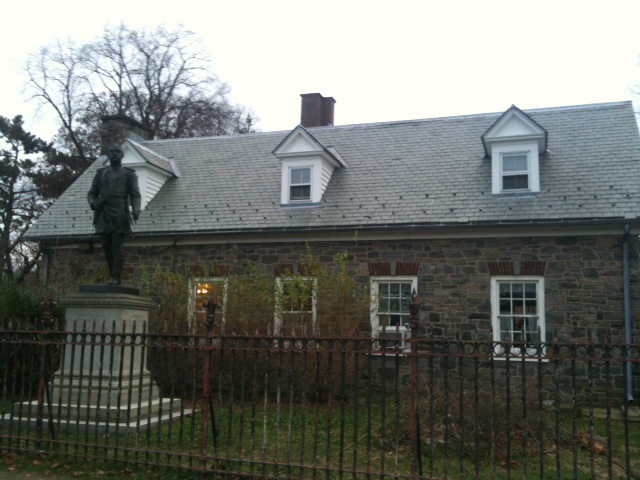
The land on which the house sits was purchased from the Dutch West India Company in 1670 by Frederick Philipse, then New York’s richest man and likely sole 1 Percenter. His son-in-law was a merchant named Jacobus Van Cortlandt, who in 1710 became the first mayor of New York born in the colony. Jacobus would also become known as the grandfather of John Jay, Founding Father and first Chief Justice of the United States. Like so much of the rest of early American histories, the story behind the Van Cortlandt house skews white, male, and wealthy. Anyway, Van Cortlandt inherited the land from Philipse, and his son Frederick would begin work on the family manor in 1748, which his son would have to finish as Frederick died that same year. The Georgian style home was made of local fieldstone and served as a base during the Revolutionary War for Rochambeau, Lafayette, and George “Still No. 1 With Me” Washington.
The family would live in the home until the property was sold to the city in 1889. In 1896, the National Society of Colonial Dames in the State of New York founded the Van Cortlandt House Museum and helped begin the work of preserving the historic home so that it could be shared with future generations of dames, damsels, and dowagers. The Van Cortlandt house has been open to the public as a museum since 1897 and was added to the National Register of Historic Places in 1967.
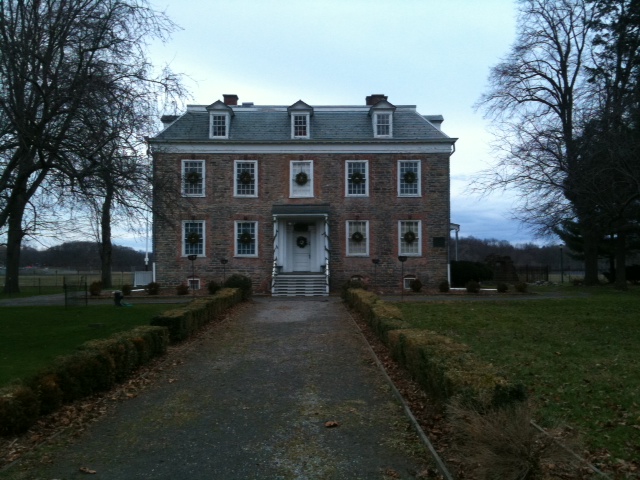
We didn’t get to go in though. Apparently you had to book reservations to see Santa in advance, and even though we explained that we didn’t believe in Santa or really care about him at all, we still weren’t allowed in by the museum employees, though we could see Santa entertaining a group of children through a few of the windows, and boy did it look cozy in there.
Christine, Meghan, and I left the park. Christine had noticed a Mexican restaurant across Broadway on the way in, so before we returned to Manhattan, we warmed up with nachos, quesadillas, and counterintuitively, margaritas.
